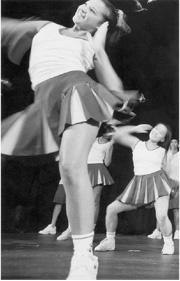Tracey Fugami stands in the door of the RAWgallery in a tank top and yellow twill overalls. Her blatantly tattooed arms offer stark contrast to her round baby face. On one arm, there’s a skeleton that reaches from shoulder to elbow. “I had that done when I was 16, to get back at my parents,” she says. Now 22, Fugami has just been hired as the associate director of RAWgallery, located inside the Theater Off Jackson.
RAWgallery
409 Seventh S, 340-1445
Thu-Sat 7-9, Sun 2-4, and by
appointment
Sponsored by the Northwest Asian American Theater, RAW is devoted to showing art by emerging Asian-American artists. The acronym, borrowed from a play by Diana Son, stands for Raunchy Asian Women. Appropriately enough, RAW’s first show in July spotlighted Irene Kuniyuki, a third-generation Japanese-American lesbian photographer and filmmaker whose works sometimes rankle the senses. Perhaps unfairly, her work is better known for its shock value. Her short film, Splayed Molecular Time, drowns its subject, a dancer, in static and high-pitched dissonant music. The bulk of Kuniyuki’s work is more accessible: Cibachrome portraits, small black-and-white cityscapes shot from a pinhole camera, images of naked butoh dancers, tattooed lesbian lovers, and taiko drummers.
At 35, Kuniyuki remains unrepresented by a major gallery. The reason for this, she believes, is that most of her photographs do not meet the expectations of either Asian-American or white audiences. It’s a politically loaded—and debatable—point, one that’s perhaps the result of working too long in the margins of the city’s art scene. But Kuniyuki’s statement does point to a real gap between younger Asian-American artists and the conventional expectations of an audience used to Orientalist images of geishas, Zen landscapes of mountains and water, and imperial costumes. To these eyes, Kuniyuki says, her art “isn’t Asian enough.”
It’s an odd predicament for a minority artist, especially in a city with a long history of fostering Asian—and, by extension, Asian-American—arts. When SAM opened in 1933 at Volunteer Park, the museum was largely endowed by the Fuller family, whose love for the fine arts of Asia formed the core of their collections. Then, in the ’50s, came the celebrated Northwest school—Mark Tobey and Morris Graves—whose works alluded to Zen philosophy and Far Eastern mysticism. The work of the region’s well-known Asian-American artists reflect this past: Seattle-born Andrew Chinn’s Chinese-style watercolors, George Tsutakawa’s sumi paintings, and Northwest mystic Paul Horiuchi’s use of calligraphy.
While Kuniyuki doesn’t care to follow in the footsteps of this older generation, she understands too well the practicality of playing up to their visual legacy. Lately, she’s been stamping a red Japanese calligraphy insignia on the corner of her images. “Now, people come up to me and say, ‘Oh, there’s something so authentic about your work.'” Sales of her photographs have been on the rise; Kuniyuki credits the insignia.
Because of its relative youth, the thematic range of contemporary Asian-American art is narrow. It’s for that reason, Fugami suggests, that viewers don’t know what to make of works such as Kuniyuki’s, which don’t fall into easy cultural categories. Fugami believes that accessibility and exposure will go a long way in educating her core audience—the Asian-American community. RAW is centrally located in the International District, right next door to the 31-year-old Wing Luke Asian Museum, one of the nation’s most prominent supporters of Asian-American social history and culture.
Will RAW’s politically correct agenda compromise artistic standards? Fugami insists not. “I only show art that I feel meets the standards of larger, mainstream galleries,” she says. “It’s part of giving back to the community. We can’t expand or grow as artists if we don’t take the art seriously enough.”
This month, RAW holds the debut exhibit of Cornish student Jason Wang, whose realist paintings and mixed-media works focus on the decomposition and preservation of religious symbols. One piece shows a cross and a copy of the Bible cast in resin and wax, appearing like a frozen artifact. Another Bible is propped open, its pages burned and tattered. A coarse patch of boar’s hair is singed with the cross sign. A series of resin-and-wax blocks with randomly spaced text obscure a color photograph of a blond child. The works are tidy and well-executed. And nothing about them explicitly signals that they are done by an artist of Taiwanese heritage.






